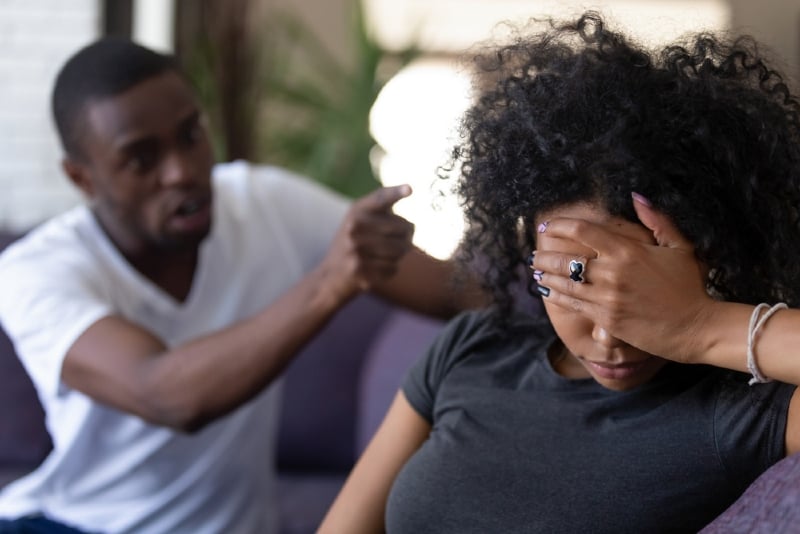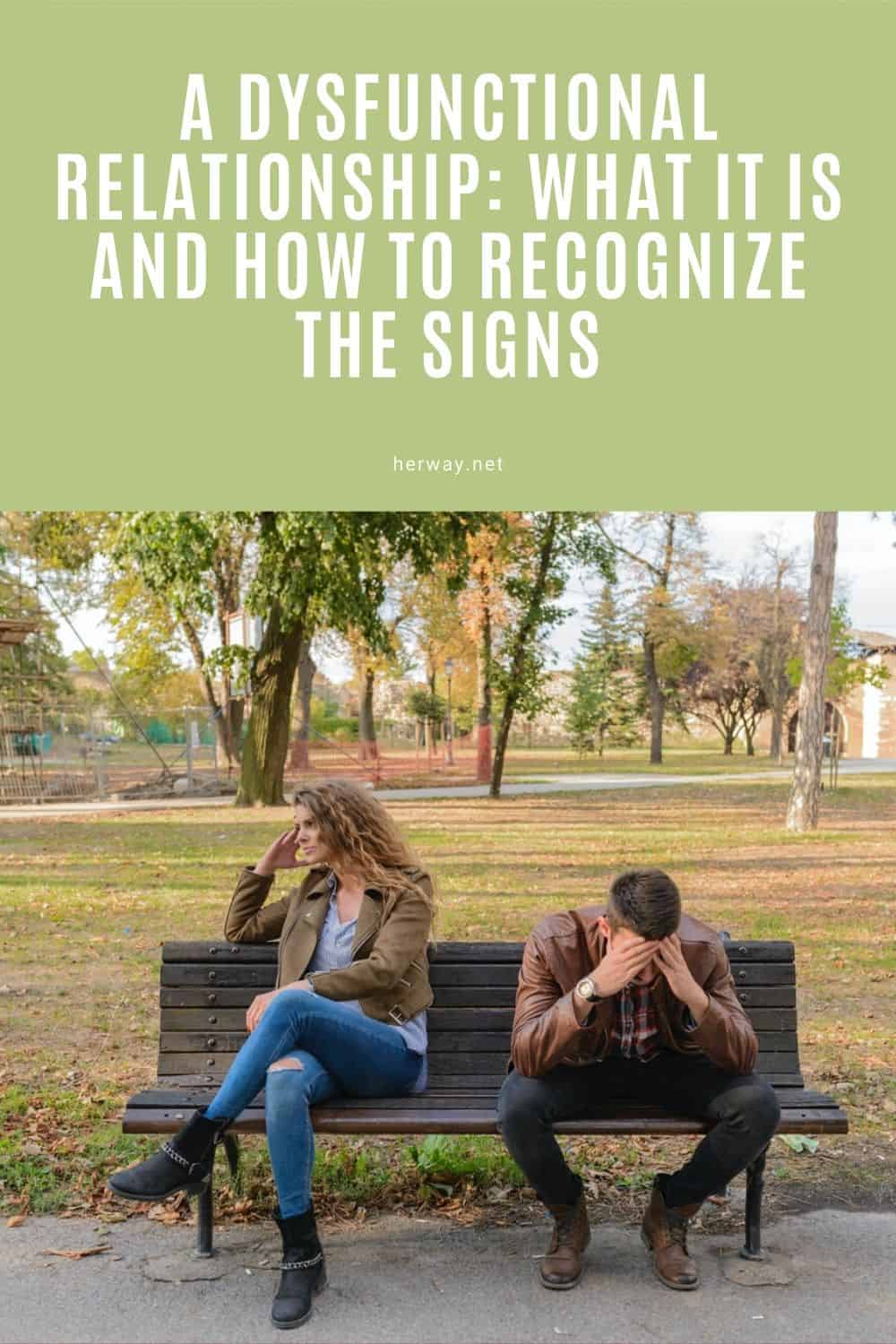Let’s start off by saying that perfect relationships don’t exist.
Most of us can be a little dysfunctional every now and then but what makes this different from a dysfunctional relationship is an awareness of the problem and a willingness to solve it.
So, what are dysfunctional relationships?
Dysfunctional relationships are relationships that don’t serve their function: They don’t emotionally support their participants and they don’t encourage healthy communication or behavior.
This term can relate to any type of relationship, be it a romantic relationship or a family relationship. Any bond between two people can become or start off as dysfunctional.
Other terms used to describe similar behavioral patterns are toxic relationships and codependent relationships.
A Codependent relationship or codependency is when a codependent is entrapped in a relationship with a partner who is often (but not always) an alcoholic, drug addict, or abuser.
A codependent makes the relationship more important than themself. The term is used to describe a relationship in which one person is unable to leave despite being emotionally or physically abused.
A toxic relationship is a term used to describe a more severe case of mental, emotional, and physical abuse.
All of these terms describe relationships that are based on unhealthy behavior and they’re often used to describe the experiences of people who grew up in dysfunctional families (for example, adult children of alcoholics, drug addicts, abusers, narcissists, and other people who grew up in dysfunctional family systems).
Unfortunately, it’s not unusual for those people to end up in relationships with toxic people and repeat the pattern they learned earlier in life.
One of the most important things that’s missing from dysfunctional relationships is accountability.
It’s important to understand that every relationship can become dysfunctional at some point. It often happens when there are unaddressed issues that result in passive-aggressive and other damaging behaviors.
Knowing all this, it’s good to watch out for the signs of dysfunctional patterns in our relationships and try to address them properly. Here are the most frequent signs.
1. Frequent unresolved conflicts
“It is better to break your own heart once than having someone breaking it every day.” – Unknown
Conflicts stem from a lack of comprehension. The inability to understand the other.
They are unavoidable in any relationship. It’s normal to have conflicts, especially when it comes to some kind of crisis, new life stages, and family matters.
In fact, they can often lead to a better understanding and improve the quality of the relationship.
Without conflict, relationships would stagnate. Only when confronting something, do we have the opportunity to change it for the better.
However, it’s not always easy to see the benefits of conflicts, especially when the people involved don’t see conflict as an opportunity for growth but as a way to impose power on another person.
In that case, conflict is nothing but a destructive form of communication that causes imbalance and disconnection.
Bearing in mind everything that has been said, it’s still true that an excessive number of fights that don’t end in mutual understanding are a harmful behavioral pattern.
When the people involved in a relationship don’t see problems as something that should be solved with joined forces but instead accuse each other of being the bad guy for causing the problem, there’s no way out.
The blame game is a vicious circle.
Treating the problem as something that doesn’t apply to them is down to a lack of comprehension and similar experiences.
Working on solving the problem together is the only way conflicts can be turned into something beneficial.
2. Imbalance of power
As I said previously, in order to achieve healthy communication, people must work together. The thing that stops this from happening is an imbalance of power.
What is an imbalance of power?
Have you ever felt like you are lower down in the hierarchy in a relationship that’s supposed to be based on equality and respect?
Like you’re under someone else and have no right to speak about or do certain things? That’s it.
Instead of using one’s beneficial dominant traits in either a mentally, emotionally, or physically useful and stimulating way, there’s a tendency to take advantage of others because of the given opportunity.
Relationships require sharing and cooperation and that takes two. Imbalance happens when one person doesn’t want to cooperate or share.
This type of behavior usually manifests as one of the partners being a decision-maker, which is basically saying What I want is more important than what you want.
Clearly, this equals emotional abuse and makes the other partner feel smaller and suppressed.
The goal of a relationship is to support one another, share responsibilities, and be there for each other.
In a normal relationship, you shouldn’t be scared to speak up or feel inadequate to say or do something you like.
3. Emotional disconnection
Responding to partners’ needs, engaging in their interests, and supporting them in what they love to do is one of the crucial things that build trust and safety.
Emotional trust builds intimacy and intimacy is what keeps a couple together.
Intimacy is a safe place and knowing you have somebody to count on, somebody who accepts you as you are, appreciates you, and loves you. It’s not only about the physical aspects.
Every strong relationship requires a physical, mental, and emotional connection. If one of them is missing, an imbalance occurs.
A lack of emotional connection causes relationship problems. Couples feel distant from one another and there’s a fear of sharing emotions for various reasons.
In order to restore intimacy, it’s crucial to allow vulnerability.
4. Blame and guilt
Blame is definitely one of the most common ways to destroy a relationship.
How?
Constant blaming is a form of emotional abuse. Unjustified blaming leaves emotional scars and shatters the self-esteem of the person who’s being blamed.
It’s common for a blamed person to start believing the accusations about the things that he or she has never done.
With blame comes guilt, and with guilt the person who is blamed keeps lowering their standards and ends up in a vicious circle of blame and guilt, tolerating abusive behavior.
Blame is often one of the early red flags. It can start as passive aggressiveness and slowly turn into open accusations.
5. Threats of abandonmen
Another very important dysfunctional interaction is the threat of a break-up and abandonment. This falls under the category of emotional manipulation, using fear as a fuel.
It doesn’t matter what kind of previous experiences a person has had or how mature the person is, the threat of abandonment will leave emotional scars and trigger deep-rooted fears in all humans– loneliness, isolation, and rejection.
Dysfunctional partners will use this fear to control their victims’ actions.
Verbal abuse is very real, in the same way as physical abuse. Unfortunately, it’s not always recognized as such.
6. Disrespecting boundaries and free will
“No partner in a love relationship should feel that he has to give up an essential part of himself to make it viable.” – May Sarton
To understand what violating boundaries means it’s easier when we look at what healthy boundaries look like.
While it’s true that relationships are based on intimacy and sharing personal things with the other person that doesn’t mean that we’re not allowed to have privacy.
All healthy relationships have boundaries – and they are set intentionally by a couple who have previously talked about what does and doesn’t make them comfortable.
You should never be required to sacrifice your friends, your dreams, or your dignity.
For example, if you don’t like public displays of affection, sharing passwords for your personal accounts, spending time with certain people, or going to certain places, your feelings and needs should be respected.
As long as you’re not taking away the freedom of others and care for their well-being you’re allowed to have your own preferences.
7. Hopelessness
You don’t have to fix anyone.
If you constantly feel down, oppressed, and sad in a relationship that’s the warning sign. If you feel like you can’t live your own life how you want to, the chances you’re in a dysfunctional relationship are high.
Being happy is closely associated with the quality of the relationships we have in life, especially the closest ones.
Maybe you know you love your partner but things between you just aren’t working out. Sometimes people are just not compatible and other times some bigger issues – like mental illness – aren’t addressed.
This can be true for both partners. When it comes to a mental health issue, there are lots of possible scenarios that should be taken seriously and discussed with a psychotherapist.
Maybe you’re unaware of the sacrifices you make for your significant other and they don’t seem to be aware, either. That behavior will consciously or subconsciously create a feeling of despair and underappreciation.
In that case, you have to know that you can’t save other people, you can’t do their work for them.
It’s true that being in a relationship means being there for each other, but first we need to start with ourselves and be aware of our own self-worth and our possibilities and boundaries.
8. Resentment
Resentment is a silent relationship killer.
It appears as a result of feeling like you’re being deprived of empathy and your experience is not being taken seriously or validated.
The real problem occurs because a person chooses to be silent, thinking the other person should notice their feelings – and that usually doesn’t happen.
That leads to inevitable passive-aggressive behavior that eventually results in fights. Accumulated resentment and hurt make people give up on their relationship without even trying to fix it.
What can be learned from this?
It’s important to be honest with other people and never assume their feelings.
It’s always useful to ask someone to share their point of view, feelings, and thoughts. All of us experience life differently.
9. Disloyalty
One very triggering thing in a relationship is broken trust.
It doesn’t occur only as a lie or because of cheating, it also includes talking to someone outside of the relationship and sharing intimate and private information without a partner’s consent.
It’s okay to ask friends for relationship advice, but the problem is sharing all the vulnerable feelings partners have shared in confidence.
Vulnerability takes a great amount of strength and bravery to share for most people and that’s exactly why betrayal hurts the most.
Someone outside of the relationship is not meant to hear about things said in confidence between two people.
While the third party might have good intentions, it’s also likely they will make wrong assumptions because of a lack of knowledge.
It also puts the unaware partner in a situation where they’re oblivious to the fact that someone has and can use that information against them. It’s non-consensual.
Can a dysfunctional relationship be turned into a healthy relationship?
It depends on the severity of toxic and harmful behavior. Is your physical or mental health in danger? How aggressive or willing to talk and listen is the other person?
There’s a difference between a dysfunctional relationship and a relationship that just needs more work. What is the difference?
If a relationship is dysfunctional, it’s destructive on a consistent basis and the individual isn’t able to take responsibility for their behavior.
There’s no opportunity for dialogue because there’s no mutual language. Usually, it starts with one side being hurt and ends up with both sides refusing to listen to or understand each other.
On the other hand, when it comes to a relationship that just needs some work – both parties will make an effort towards positive change. They may fight but there’s always a genuine interest in improving the relationship.
It’s true that people can change but it’s also true that change is usually a long process full of ups and downs.
There are so many different stories and possible scenarios, but one thing is clear: If you feel threatened, put down, miserable, and hopeless – you should leave the relationship.
It’s also true that toxic relationships are sometimes the product of both partners refusing to cooperate and give each other a chance.
5 things to do to fix your dysfunctional relationship
1. Don’t pour fuel on the fire
When we’re aware of someone’s bad behavior, the biggest problem is refraining from criticizing them all the time.
Unfortunately, the other person, who is the cause of the harmful behavior, sees and feels things differently.
If we’re angry about someone’s drinking problem, they will not see the problem in themselves, but in our constant criticism.
The person who is focused on everything but their own wrongdoings blames everything else. They get upset and angry with you just for reacting.
That’s why we shouldn’t pour fuel on the fire. That doesn’t mean walking on eggshells but when they’re overly defensive, don’t argue back because their emotions are stronger than their rational side.
That’s why there’s no point in trying to prove something because everything will be misinterpreted.
It’s best to stay collected and calm and try to solve the problem or talk to them after their emotions calm down.
Sometimes, the best approach can be just talking, asking why, and listening.
2. Learn to say no
Sometimes when we try to help an easy situation, we’re actually doing the wrong thing. This usually happens when the other person takes what we do for granted.
It’s okay to care and help, but there’s a line when what they’re asking is too much. You’re not responsible for other adult human beings that choose to harm themselves and others.
Don’t get lost in helping people who aren’t able to understand what you’re doing and respect your willingness to help.
Don’t get stuck in a this is the last time mindset because that’s how you’ll end up doing it every time. Sometimes saying no, not helping, and not giving in is actually better than doing something for them.
Learn to say no and think about your boundaries and the fact that you too need care and respect.
3. Understand the core issue
Every serious issue starts with an unresolved inner problem. Sometimes that problem isn’t obvious to the person who has it and other people around them don’t seem to see it either.
Without stepping back and empathy we can’t see the core issues that might be obvious. Understanding and taking the opportunity to express emotions is more likely to give the results.
This, of course, works when there’s still a possibility of self-reflection in the afflicted person and they show signs they want to change.
If the conversation is possible, it’s important not to deny their feelings but listen to their needs, work on their goals, and show support.
4. Don’t encourage irrational thoughts
I mentioned that people change, but the truth is – it’s not something that happens frequently.
For some people choosing a seemingly easier way to deal with their problems (it doesn’t matter if it’s alcohol and drugs or anger issues and withdrawal) is something they are used to and will probably go back to doing if they don’t change their life completely.
Thinking that somebody will change overnight is a fairytale. It’s crucial to stay rational and see things for what they are. Only one time and never agains usually end up being unintentional lies.
Change requires discipline, full commitment, and leaving old behavior behind for good.
5. Understand emotions, but don’t support behavior
You should be empathetic, but you shouldn’t try to rationalize or support toxic behavior. It’s important to divide the two.
It’s possible to treat the core issue of the problem, but it’s still necessary for the person to take responsibility for their actions – or talking about issues is useless.
Taking responsibility for the things that are hard to talk about is the first step to healing.
How do I know if my relationship is dysfunctional?
Try asking yourself the following questions and think about the answers in detail:
After a conflict, does your partner insist on making you feel like the bad guy and try to punish you in some way?
Do you feel like you just can’t win? Do you feel resentment? Why?
Does your partner threaten to break-up with you and leave when they get angry?
Does he or she always need to have the last word?
Do you feel like things aren’t going to change?
Does your partner tell you to behave a certain way and expect you to do things you disagree with?
Does your partner promise you he or she will change and later on break this promise?
Do they make the same mistakes over and over again?
Conclusion
“Stop setting yourself on fire to keep someone else warm.” – Unknown
Dysfunctional relationships are a result of systematic emotional neglect starting in each person individually way before the relationship.
Why? Everybody carries their own emotional and mental wiring and their conscious and subconscious beliefs, values, and fears that are molded by their experiences, their family, parents, friends, etc.
It’s important to advocate empathy and give second chances, but it’s also important to teach hurt people to stand up for themself.
Every situation is unique and that’s exactly why general rules don’t always apply – especially when it comes to something so intimate, personal, and vulnerable.
However, in order to protect people who are being abused, stressing the importance of self-advocacy, setting personal boundaries, asking for help, encouraging them to speak up, and validating their experiences and traumas is a must.
There’s no change if the change doesn’t start inside of us first. Toxic behavior is supported by an inability to leave old beliefs that don’t serve us and insisting that only what we see and do is right.
Other than that, it’s crucial to accept our emotional side and practice vulnerability.
People fail to notice that excess of pain at one point in the life of a human being is often what later causes something that looks like insensibility.
Sometimes a lack of empathy or an inability to understand the other is nothing but a refusal to allow the potential pain that comes from feelings we once felt when we got hurt.
To love and to feel is already a gamble. We usually can’t predict our feelings and we’re extremely scared of pain. That’s why we create the culture of not caring.
To say that we don’t care is to prolong the existing anguish and strip ourselves from the opportunity to grow and explore ourselves. Saying I can’t live without something/someone is the different side of the same coin.
One standpoint refuses to take action because of the underlying fear and the other standpoint doesn’t want to take responsibility for the same reason.
Without pain, there’s no growth. Without growth, there’s no going forward, there’s no change.
For some people taking the first step means admitting their addiction or bad behavior. For others it means admitting that someone is using them and having the courage to leave the situation they’re in.
It’s scary to change your life completely and leave the things that once made you feel safe. It’s scary to leave something we’re familiar with and change it for uncertainty.
However, it’s the only way for things to change for the better. There’s no magical way to escape bad and painful things. It’s not enough to just think that things will change or pass – you must take action.
It’s possible to have a healthy and good life after a difficult relationship, you just have to believe in yourself and be determined to reach your goal.




















